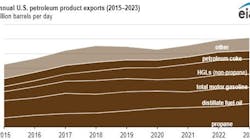Alex, the first hurricane of 2010, came ashore on Mexico's Tamaulipas coast in a Category 2 status June 30, flooding Matamoras but scarcely impacting Brownsville or other parts of South Texas just across the border.
It also dumped heavy rain on Monterrey before dissipating July 1 over Mexico's central mountains. It missed the major oil and gas production areas in the Gulf of Mexico and did not interfere with the cleanup or drilling of kill wells for the Macondo blowout off Louisiana, said officials at the US Bureau of Ocean Energy Management, Regulation, and Enforcement, the replacement of the Minerals Management Service.
But it temporarily shut down Mexico's two main crude loading terminals and the ship traffic at Houston and Corpus Christi, Tex. Those disruptions likely will show up as a further reduction in US imports in a future inventories report.
Olivier Jakob at Petromatrix, Zug, Switzerland, noted at the time, It was the strongest hurricane for a month of June since 1966, and there will be more hurricanes to come in the season." Industry analysts and meteorologists generally expect an unusually active hurricane season this summer.
'A glimpse' of effects
Alex gave the Gulf Coast a glimpse of how this year's hurricane season is likely to affect oil prices," said analysts at KBC Energy Economics (formerly KBC Market Services), a division KBC Advanced Technologies PLC in Surrey, UK. West Texas Intermediate crude spiked close to $80/bbl as Hurricane Alex gained strength in the Gulf of Mexico," they said.
Actually, the new front-month August contract for benchmark US light, sweet crudes increased 16¢ to $76.51/bbl June 24 on the New York Mercantile Exchange as the possible threat of a tropical storm topped market concerns about setbacks to economic recovery. On the US spot market, WTI at Cushing, Okla., was up 68¢ to $76.16/bbl as it tried to get back in step with the NYMEX front-month contract price.
On June 25, a Friday, energy prices continued climbing with crude jumping $2.35 to $78.86 bbl on NYMEX. On the spot market, WTI rose $2.70 to match the front-month crude futures price. By June 28, however, both the August futures contract and the open market prices were down 1%, ending a 2-day rally due to austerity promises by the Group of 20 governments meeting June 26-27 in Toronto, lower consumer confidence, and reduced threat from Alex to production facilities in the gulf.
On June 29 as Alex approached the upper Mexican and lower Texan coasts, the August crude contract fell 3% on NYMEX, its biggest drop since June 4, and the new front-month natural gas unit tumbled 3.9% on reports of slumping consumer confidence in the US and China's slowest growth rate in 5 months. By July 2, the front-month August contract was down to $72.14/bbl, so while the storm did stimulate the market some early on, the bigger changes were triggered by market fears of a slowing economic recovery.
During the storm, some 420,000 b/d, or about 25%, of gulf oil production was shut in as a precaution, as oil companies adopt a squeaky clean approach following the disastrous BP PLC oil spill in the Gulf of Mexico," said KBC analysts.
On June 30 when Hurricane Alex made landfall, BOE said personnel were evacuated from 74 of the 634 manned platforms and 8 of the 51 mobile drilling rigs in the gulf. It said 26.33 % of oil production and 14.36% of natural gas production in the gulf were shut-in. In its final report on July 3, BOE said personnel still have not returned to 15 of the platforms and 2 of the rigs. It said 1.13 % of gulf oil production and 2.08% of total natural gas production were still shut in.
Lower crude prices
Halfway through the year, oil prices are…close to the lows of their 2010 trading range," with WTI and North Sea Brent both finishing well below $73/bbl July 2, close to 3-week lows", said KBC analysts.
The first half of the year has seen a Brent futures high of $89.58/bbl and a WTI futures high of $87.15/bbl, and lows of $67.87/bbl and $64.24/bbl, respectively. The average for both benchmarks has been around $79/bbl over the first 6 months of the year," KBC analysts reported. The latest bout of short-term weakness comes on the heels of disappointing economic data, which has fuelled lingering fears of a double-dip recession," the said, adding that recent global reports indicate economic recovery is flagging.
(Online July 6, 2010; author's e-mail: [email protected])
More Oil & Gas Journal Current Issue Articles
More Oil & Gas Journal Archives Issue Articles
View Oil and Gas Articles on PennEnergy.com

